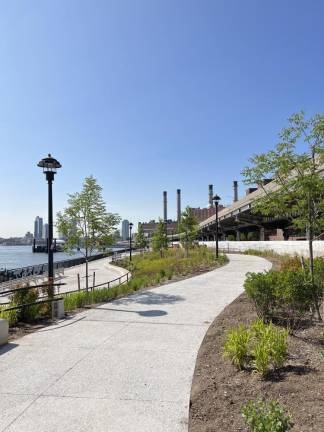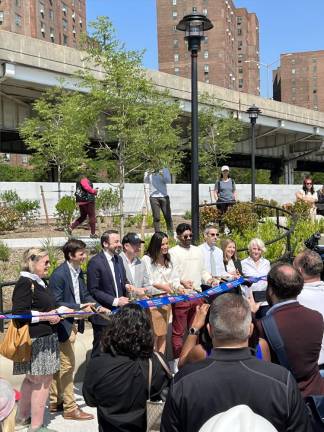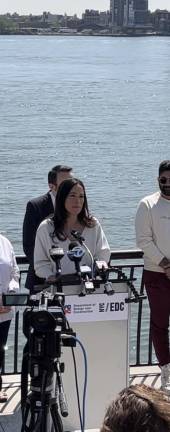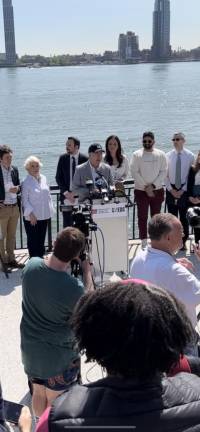First Chunk Of Stuyvesant Cove Park Reopens, Doubling As Floodwall And Rec Space
At a May 30th ribbon-cutting, prominent locals–ranging from City Council members Keith Powers and Carlina Rivera, to the executive director of the mayor’s climate office–lauded the partial opening of the reworked Stuyvesant Cove Park on the East River. Officially designated as part of the East Side Coastal Resiliency Project (ESCR), the park will serve as both flood barrier and recreational space–necessary in an era of increased hurricane forecasts. Over the process of construction, critics swore that the process of destroying the surrounding parkland to create the seawall was not adequate for its intended result.




After a few years of closure, Stuyvesant Cove Park is being resurrected from the dead with the backing of the city government and the environmental nonprofit Solar One.
A blindingly sunny ceremony marking the ribbon-cutting of the park’s E. 20th to 23rd St. section was held on May 30th. Various dignitaries, local politicians, and supportive residents christened a carefully manicured stretch of East River coast that will double as a floodwall and recreational hang-out. The remainder of the park (starting on 18th St.) will made available to the public by the end of the summer.
Billed as the second iteration of the East Side Coastal Resiliency (ESCR) project, the park will reputedly contain 75 new trees and 579 new shrubs. 1,180 feet of concrete seating arrangements will also be present in the 1,400 foot finished park, not to mention chairs and tables–some already in use by weary relatives of the assembled elites at the time of the ribbon-cutting. Two floodgates have be installed, a sixteen ton swinging gate at E. 23rd St. and a seventy-seven ton sliding gate at E. 20th St.
The ESCR, a nearly one-and-a-half billion dollar climate resiliency project designed to also provide open use areas for thousands of downtowners, was conceived as a sort of preventive prophylactic for possible future hurricanes in the traumatic aftermath of Superstorm Sandy. The refashioned Stuyvesant Cove Park–along with the already refurbished Asser Levy Playground, named after one of the city’s first Jewish residents, by 25th St–is intended to constitute part of a 2.4-mile-long system of berms, walls, and gates intended to halt inclement weather in its tracks.
The ESCR faced tumultuous community opposition after its announcement, largely centered around the destruction of existing park greenery and trees. The original report commissioned by the city noted that “to the extent practicable, the City would transplant existing park trees that are in excellent condition and, based on prior NYC Parks arborist experiences and approvals, are suitable for a successful transplanting. Second, approximately 1,815 trees are proposed to be planted as part of the landscape design within the project areas, which would result in a net increase of 745 trees over the existing conditions.” The 75 trees included in the new Stuy Cove Park will ostensibly be part and parcel of that estimation.
However, then-Manhattan Borough President Gale Brewer who is now an Upper West Side Council Member commissioned her own independent review of the ESCR with the assistance of Dutch nonprofit Deltares. Her review was a response to a March of 2019 report issued by the New York Panel on Climate Change that noted a projected sea level rise of 9.5 ft. by 2100, which would blow by the then-projected 30 inches of added storm barriers provided by the ESCR. This is perhaps because the ESCR is only intended to take into account sea level rise by 2050.
Brewer’s report directly addressed that concern, stating that: “Based on the community’s resistance to the removing of trees and vegetation, it is recommended including the additional two feet of fill be considered in the current project, rather than leaving it as a future option,” the report reads. “Including it in the current project would avoid having to remove the mature vegetation around the 2050s, when sea level will likely reach a level that the two additional feet will be needed.”
Yet such community fears were hard to find on opening day.
NYC Department of Design and Construction Commissioner Thomas Foley shepherded the ribbon-cutting proceedings, the sunlight refracting off the East River onto his fellow speakers. At one point, a seaplane carrying an intrepid crew member on its floats stalled just off-camera. “An amazing, amazing park we’re opening today. This is the northernmost section of the ESCR, one of the largest resiliency projects going on in the world,” Foley said.
He also noted that the seating arrangement arrayed around him could also function as a flood barrier, which on such a placid day didn’t seem to disturb any of the assembled guests. New York City Economic Development Corporation President and CEO Andrew Kimball stepped up to the podium next to add that the park, as a “magnificent addition to our city’s public realm,” will “enhance our resiliency against the effects of climate change, and simultaneously enhance the quality of life for New Yorkers from near and far who will enjoy it.”
Victoria Cerullo, Acting Executive Director of the Mayor's Office of Climate & Environmental Justice, spoke next. “The waterfront is a place for play, for joy, for community building. This project connects the dots of resiliency and equity, which is so critical,” Cerullo said. She also brought up PlaNYC: Getting Sustainability Done, the Mayor’s overarching climate policy plan, which the reopened park certainly squares with in spirit and in policy–even if other guests didn’t quite point this connection out.
Keith Powers and Carlina Rivera, the representatives for City Council’s District 4 and District 2, respectively, emphasized what was on everybody’s mind by zeroing in on the dreadful aftermath of Superstorm Sandy–and they made sure to focus on their personal experience of the disaster. Both conjuring bleak memories of cars being lifted by floodwaters and doors being knocked on to evacuate residents, the representatives also gave fond shout-outs to their mothers as they implied how hurricanes–past and future–pose a threat to older generations. “I’m so proud to stand here, to see this critical flood protection improvements unveiled here at Stuy Cove Park. This is the beginning of something really, really incredible,” Rivera enthused.
Nodding to the history of Stuyvesant Cove Park itself and the struggle inherent to opening it in the first place, Powers reflected on what it meant to transform the site of “an abandoned cement plant into a slice of greenery.” As the planted trees in the opened swath of park remain only saplings at this juncture, this functioned as more aspirational statement than present reality.
Stuy Cove Park will function as a public-private partnership between the city and Solar One. Solar One CEO Stephen Levin said that a 3,000 square foot environmental education center on the northern end of the park would break ground within the next month.
“Solar One has been the steward of Stuyvesant Park for almost two decades,” Levin added. “In that time, we have striven to make this stretch of open space along the East River a piece of coastal ecology, within our teeming metropolis. [We acknowledge] that prior to the establishment of New Amsterdam in the 1600s, the adjacent coastline provided the Munsee band of the Lenape people with fish, wild game, and edible and medicinal plant that sustainably supported their daily needs. We look to that history as our guide for being responsible stewards of this land.”